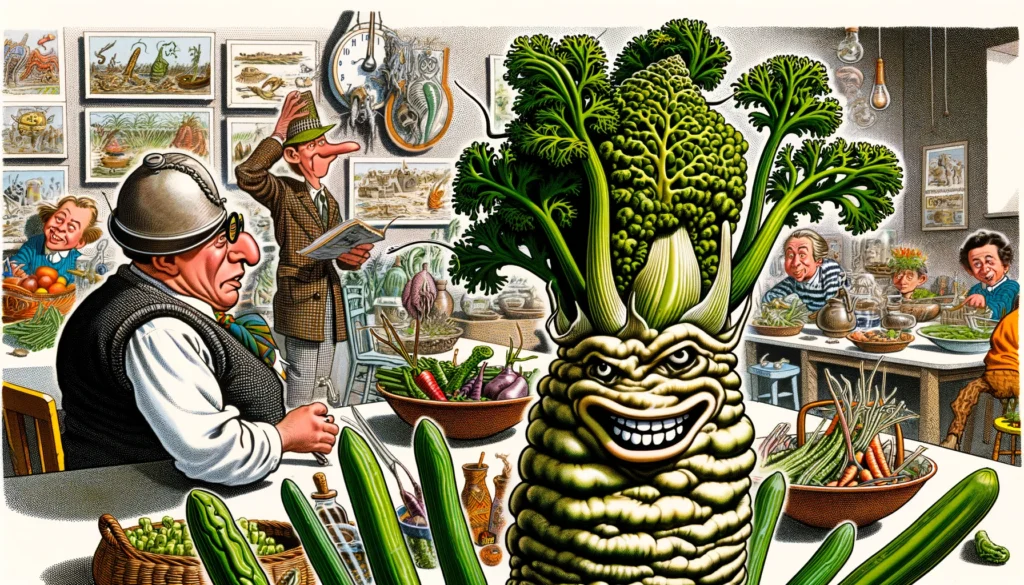
Rare Vegetable A humorous and detailed close up illustration in the style of Mad Magazine depicting an exotic vegetable Samphire. The scene shows the vegetable with2.webp.webp
Samphire: The Salty Green Delicacy from the Sea
In the bustling world of vegetables, where land-based greens like lettuce and kale dominate, a salty contender from the coast is making waves. Meet Samphire (Salicornia europaea), the succulent plant also known as sea asparagus. This rare gem from the coastal regions of Europe and North America is ready to infuse your culinary creations with a taste of the ocean.
The Rise of Samphire
Samphire, with its origins in the coastal regions of Europe and North America, is a plant that thrives in salty environments. Often found growing in marshes and along shorelines, samphire has a distinct salty flavor that sets it apart from its terrestrial cousins.
“Samphire is like the kelp’s sophisticated sibling,” says marine botanist Dr. Salty Seabreeze. “It’s got the saltiness of the sea but with a crunch that makes it irresistible.”
Despite its unique flavor and texture, samphire remains a rare find in mainstream markets. Its specific growing conditions and seasonal availability make it a prized catch for chefs and food enthusiasts looking to add a touch of the ocean to their dishes.
The Culinary Potential of Samphire
With its salty flavor and crisp texture, samphire is a versatile ingredient that can elevate any dish. It’s often used in salads, seafood dishes, and as a garnish to add a burst of briny freshness.
“Samphire is a game-changer in the kitchen,” says Chef Snout. “Its salty flavor pairs perfectly with seafood, and its crisp texture adds a delightful crunch to salads and other dishes.”
However, cooking with samphire is not without its challenges. Its naturally salty flavor can overpower a dish if not balanced correctly. But for those who master the art of cooking with samphire, the rewards are well worth the effort.
Farmers Contemplating Growing Samphire: A Satirical Guide
For farmers considering the plunge into growing samphire, be prepared for a journey filled with salt, sea, and adventure. Here’s a satirical guide to help you navigate the whimsical world of samphire farming.
1. The Salty Shores: Samphire’s natural habitat is the coast, so if you’re planning to grow it inland, consider turning your farm into a saltwater marsh. Don’t be surprised if you attract a few curious seagulls.
2. Briny Business: Samphire’s salty flavor might attract all sorts of critters. Consider installing a mini lighthouse to ward off any adventurous crabs or sea creatures.
3. Coastal Appeal: Growing samphire will make you the talk of the town. Prepare for gourmet chefs knocking on your door, begging for a taste of your salty green delicacy.
4. Culinary Challenges: Experiment with different cooking methods to find the perfect balance of salty flavor. Don’t be afraid to get creative—samphire is all about bringing a taste of the ocean to your plate.
5. Limited Edition: Market your samphire as a limited-edition coastal treasure. Its rarity and unique flavor make it the perfect candidate for a culinary adventure.
The Samphire Revolution
As more chefs and food enthusiasts discover the magic of samphire, this salty green plant is poised to revolutionize the culinary world. Its unique flavor and crisp texture make it a standout ingredient that’s impossible to ignore.
“Samphire is the vegetable equivalent of a gourmet salt shaker,” says food critic Briny Bite. “It’s got the flavor, the texture, and the attitude to take the culinary world by storm.”
With its rising popularity, samphire is no longer content to be a hidden gem. It’s stepping into the spotlight, ready to dazzle and delight anyone who takes a bite.
Conclusion: Embracing the Salty Green Delicacy
In conclusion, samphire is not just a vegetable—it’s a culinary experience. From its salty flavor to its crisp texture, samphire brings a burst of the ocean to any dish. As more people embrace this exotic plant, the culinary landscape will be forever changed.
So the next time you come across samphire in a specialty market, don’t hesitate to give it a try. Let its salty flavor and crisp texture take you on a culinary adventure you won’t soon forget.
Disclaimer
This article is a human collaboration between a cowboy and a farmer. No sea asparagus were harmed in the making of this satire, although several did enjoy a bit of extra seasoning. Always consult a culinary expert before attempting to cook with rare vegetables. Remember, sea vegetables are for eating, not just for admiring.
15 Educational Facts About Samphire (Salicornia europaea)
- Samphire is like the kelp’s sophisticated sibling—if kelp wore a tuxedo and went to fancy dinners.
- Eating samphire is like taking a bite out of the ocean without getting wet.
- Samphire’s salty flavor is its way of saying, “I bring the sea to your plate.”
- If samphire could talk, it would probably ask for a side of seafood.
- Samphire looks like what happens when asparagus decides to take a beach vacation.
- The only thing missing from samphire’s salty crunch is a seagull swooping down for a bite.
- If samphire were a party guest, it would be the one who brings the fancy sea salt as a gift.
- Samphire’s natural habitat is so salty, it makes the Dead Sea look like a freshwater lake.
- Samphire’s idea of a perfect day is basking in the coastal sun, soaking up all the salty goodness.
- If samphire were a drink, it would definitely be a salty margarita.
- Samphire is like the ocean’s answer to salad—crisp, fresh, and full of briny flavor.
- The only thing samphire loves more than the sea is being the star of a gourmet dish.
- Samphire’s salty taste is its way of reminding you that it grew up by the sea.
- If samphire had a hobby, it would be sunbathing on a rocky shore.
- Samphire’s crisp texture and salty flavor make it the life of any culinary party.
Originally posted 2017-02-17 03:33:48.
Originally Published at FarmerCowboy.com
2024-12-12 04:06:19
Karl Hoffman is a distinguished agriculturalist with over four decades of experience in sustainable farming practices. He holds a Ph.D. in Agronomy from Cornell University and has made significant contributions as a professor at Iowa State University. Hoffman’s groundbreaking research on integrated pest management and soil health has revolutionized modern agriculture. As a respected farm journalist, his column “Field Notes with Karl Hoffman” and his blog “The Modern Farmer” provide insightful, practical advice to a global audience. Hoffman’s work with the USDA and the United Nations FAO has enhanced food security worldwide. His awards include the USDA’s Distinguished Service Award and the World Food Prize, reflecting his profound impact on agriculture and sustainability.



